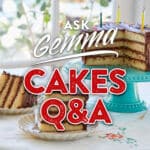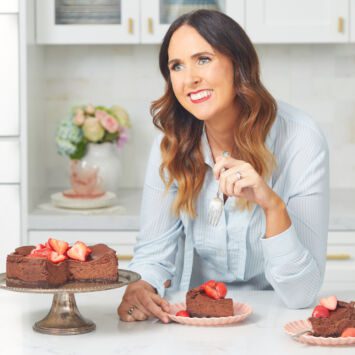
This post may contain affiliate links. Please see my full disclosure for details.
Hi Bold Bakers!
This is Patricia, Gemma’s Mum. I have had my fair share of ovens over the years, from gas to electric, to even an AGA. What have I learned over 50-plus-years of cooking? Ovens vary, that is a fact. Over time the thermostat, which controls the heat of your oven, will go off, and not be the same as my oven, or your friend’s oven, or the last oven you used. This means that you need to pay attention to your baking, learn how to monitor it for doneness, and never just abandon it to its own devices! So, here is a Guide to Knowing Your Oven.
So what is a Convection Oven?
A convection oven uses a fan that is usually located on the back of the oven. The fan circulates the hot air around the cavity of the oven, maintaining the heat and cooking the food quicker than a conventional oven. Not only does a convection/fan oven cook food more quickly than a conventional oven, but it also cooks food at lower temperatures. The temperature suggested by your recipes can be adjusted downwards (roughly 25o° F) when cooking in a fan oven, or alternatively, the time can be reduced. As the hot air circulation in a conventional oven is consistent food can easily be cooked in batches, it should cook evenly no matter where it is placed in the oven.
What is a Conventional Oven?
Conventional ovens are similar to convection ovens in that they both cook food using heat. They can be designed to cook with either gas or electricity. In a conventional oven, the elements are situated on the floor of the oven and on the roof. The top element is used usually for broiling/grilling. Since a conventional oven doesn’t have a convection fan to circulate hot air, pockets of hotter or cooler air can cause dishes to cook faster or slower, depending on their placement inside the oven. The center shelf is often suggested for baking and roasting. Uneven cooking is especially noticeable when both the bottom and top racks in the oven are being used at the same time. The items on top will cook faster because heat rises to the tops of conventional ovens and when there is a lot in the oven, the heat gets trapped there. Trays can be rotated through the baking to ensure an even result.
What is a Gas Range Oven?
A gas range oven is fueled by combustible gas and has a stove with burners in the top and an oven chamber underneath.
The oven can be a CONVECTION oven–inside the cavity, with a fan in the rear, gas (broil) burner in the top, electric upper heating elements on the ceiling and gas bake burner below the floor of the oven. Once the set temperature is reached, the (top) broil burner will not come back on and the (floor) bake burner cycles on and off to maintain the set temperature. While BAKING, the (floor) bake burner is on with the fan running at LOW speed to gently circulate air through the cavity; while ROASTING, the (floor) bake burner is on with the fan running at HIGH speed to brown food and cook it more evenly and roughly 25% faster than a traditional conventional oven. In BROILING mode, the top burner is ignited.
It can also be a CONVENTIONAL oven–inside the cavity, no upper heating elements on the ceiling & no fan in the rear, ONLY gas bake burner below the floor of the oven. When it bakes (for baking and roasting ) , only the (floor) bake burner is on, NO top heat.
In a gas run oven (no matter convection or conventional), for BROIL, only the (top) broil burner is ignited.
All Bold Bakers Should…
Monitor a bake! which means checking it through the baking time indicated in the recipe. It means not opening the oven door more than strictly necessary. This action will change the temperature in the oven cavity and will affect the results. A fallen cake can indicate that the oven temperature has dropped before the bake is set up.
A rule of thumb is to check the bake about ¾ way through the time indicated in the recipe. Just take a peep through the glass door and only take the bake from the oven if it looks and smells done. A little touch to the top of the bake will tell a lot — if it feels firm to the touch it is most likely done. Then you can take it from the oven and test it with a skewer, or toothpick. When there is no raw dough attached you can be sure it is right. As you become more experienced you will just know at a glance. That lovely freshly baked smell too indicates that it is baked.
If your oven seems way off, and your bakes are failing, you can buy a simple thermostat which will give you an accurate reading of the temperature.
An OTG, Oven Toaster Grill operates in a different way to a large cavity oven. The instruction books for these ovens can be a big help, as will the manufacturer’s websites.
The chart below should be accurate enough for all your baking. Temperature can vary between different types and sizes of ovens, in addition to your location, altitude – which brings its own challenges – ambient temperature, humidity and the age of your appliance, etc.
DOWNLOAD MY FREE ‘Guide To Knowing Your Oven’ BELOW
I hope you find this Guide to Knowing Your Oven useful in your baking!
Best,
Pat.
Don’t forget to follow Bigger Bolder Baking on Pinterest!







Hi, this is really useful! Thanks a lot Patricia. I bake with my OTG. Someday will get a huge oven. 👍.
Would love to see you baking some traditional recipes. Made the Irish bread pudding yesterday, was yummy!!😋
Hi
Wat mode of otg shall i bake the breads? Like only bottom or both?. It would be really nice if you could elaborate on this issue.
Hi this is quite useful. I was surprised to see Gas Mark 10 in the chart as my oven has max 8. Thanks for sharing expertise knowledge. I am from Sri Lanka.
Many thanks, Patricia, with every good wish!
Thank you Patricia for this tutorial! Very informative. I use an OTC too and my girls are impressed how I can bake in it!
how do i know which heating elements should be used when baking different things? like top only or bottom only and for both at once
My microwave is 1700 watts. I know yours is 1200 watts, is the cooking time in the microwave the same with a 1700 watt microwave?
Hi Gemma! I am planning to buy one for baking brownies, cookies, breads, cakes, any pastry. Here are my questions 😅💓:
1. What type of oven do you prefer, gas or electric?
2. What type do you use?
Thank you in advance and God bless you and your family!
Good morning. I don’t know if youve ever expensive your oven going off on its own but I use an LG gas cooker oven. It hasnt been up to a year but it keeps going off on its own. I haven’t called the repairer yet cause ive noticed it only recently. If this has happened to you before can you give me some advice.
Thanks
Hello,
This article is so useful. Could you kindly elaborate on the different OTG settings? I am new to baking and would like to know which setting I can use to bake different goods. Below are the functions on my oven:
1) Only bottom heating
2) Only bottom heating with fan
3) Top and bottom heating with fan
4) Top heating + fan + grill
5) Top and bottom heating + fan + grill
Cheers!